Ah, the Eisner Awards, the comics industry’s highest honor! Everyone in comics, from the lowliest writer to the most revered letterer, knows that the capital E stamped on the cover of a comic is a sure sign of its quality! While the winners of the Eisner may not get a brick, what they do receive is far more precious: the ability to tell their coworkers at their day job that they won a thing that’s kind of like the Oscars, but for comics!
In this article, I will review the nominees for the Best Humor Publication Eisner Award for 2021, which is for humor comics published in 2020. I suppose I’m drawn to this category because I’m something of a humor connoisseur. I’m a humor cartoonist myself, and, among my friends and coworkers, I’m even considered a bit of a “Joker!” Ha ha!
The Best Humor Publication award is especially complicated because humor is so subjective. It’s easy to feel slighted when a favorite comic isn’t shortlisted, but everyone has different thoughts and beliefs about what’s funny. It’s only natural that something one person thinks is hilarious might not be funny to someone else. There is no such thing as objectively, universally funny.
Right?
On with the reviews!
The Complete Fante Bukowski, by Noah Van Sciver (Fantagraphics)
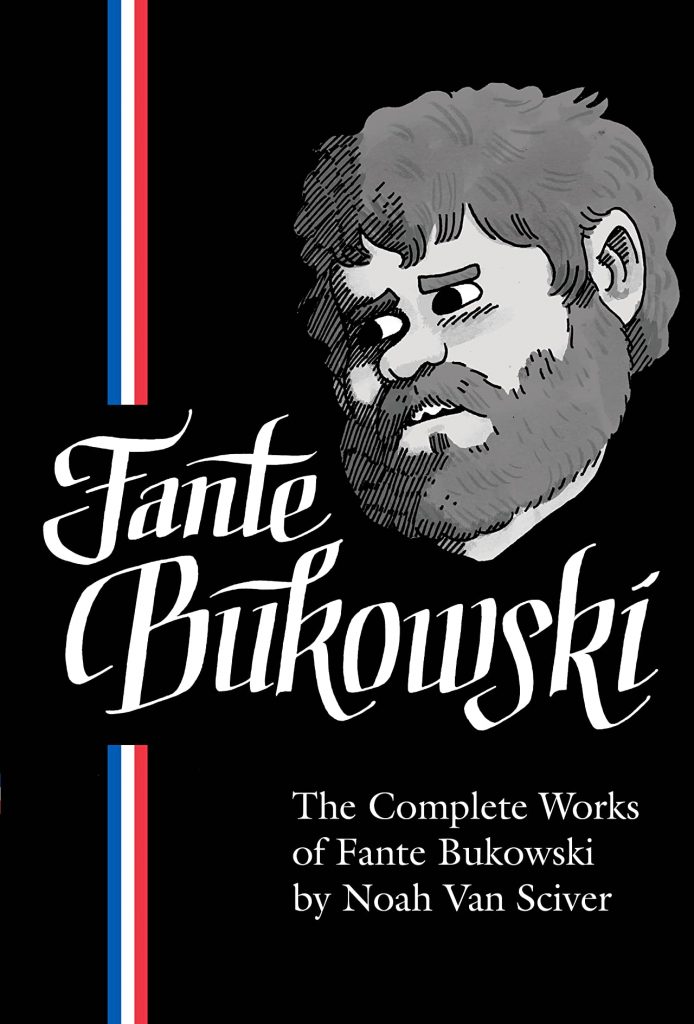
First up, we have The Complete Fante Bukowski, by Noah Van Sciver, the only person I’ve ever seen bite into a slice of pizza and sigh with disappointment. Fante, the protagonist, is a whiny, self-important, shitty writer. Van Sciver, on the other hand, is a talented artist, proficient in both line and color, and he seems completely at home with the subject matter.
Fante Bukowski was released in three parts, and It is a joy to watch Van Sciver’s linework become more open and free, especially in the third volume. Humorwise, however, the third volume brings down the average. It’s not that Fante’s origin, which is addressed in this volume, isn’t a funny idea. There are still plenty of jokes in the flashbacks, but the “emo is old” and “raccoons in the attic” bits don’t hit as hard as the shitty writer jokes.
Another issue I have is that Audrey Catron, the successful writer who serves as Fante’s foil in the first two volumes, is replaced in volume three by Norma Lee, a psychopathic performance artist. I don’t mean to suggest with the word “replaced” that there’s only room for one important female character per chapter, but it feels a bit like a Karen Allen in Raiders / Kate Capshaw in Temple of Doom situation rather than a natural depiction of the way different people move in and out of prominence in someone’s life over time.
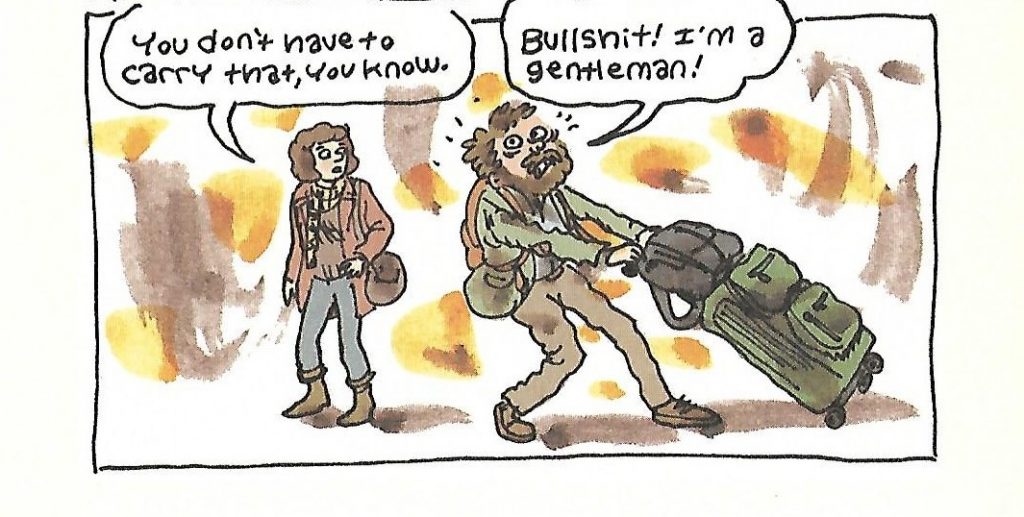
There are things I love about Fante Bukowski: the art that improves over the course of the book, as well as the way the characters begin as cyphers and stereotypes, but then you learn more about them as you go. Of course, I would be into that. It’s exactly what I’ve done in my ongoing comic strip, Meeting Comics, the first collection of which was published by Adhouse.
In 2020.
I’m just saying.
Department of Mind-Blowing Theories, by Tom Gauld (Drawn & Quarterly)
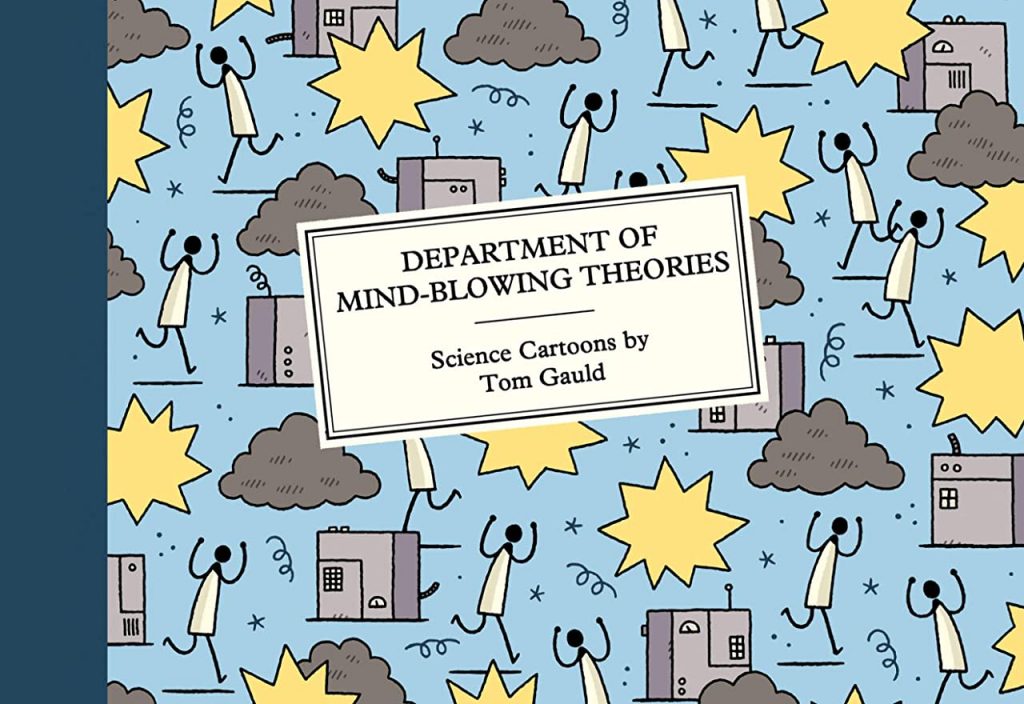
Tom Gauld’s work has always struck me as “droll,” that most British subset of “funny,” and Department of Mind-Blowing Theories reinforces that notion. Department is a collection of Gauld’s science-themed comics from The Guardian. There are some solid jokes in here, but, to use a term from physics, their potential energy is generally not realized. I feel like most of these strips would have worked better as background jokes or asides to liven up an ongoing narrative. It’s the opposite of the problem I had with Fante Bukowski, which I think overstays its welcome. This book of single-page comics never really builds up any momentum.
Maybe I’m not giving it a fair shot; after all, I said right there in the last paragraph that these are single comics, without a narrative. Is asking for momentum too much? I don’t think so. Who among us hasn’t collapsed into giggles due to the cumulative effect of a book full of Gary Larson’s comics, or Kate Beaton’s, or Michael Kupperman’s? Still, there are some good jokes in here – I particularly enjoyed one featuring a mind-reading apparatus and a squirrel – and the stiff but playful art suits the subject matter perfectly. In the end, it’s going to make a great gift for my physicist neighbor, Brian, who likes The Far Side and XKCD.
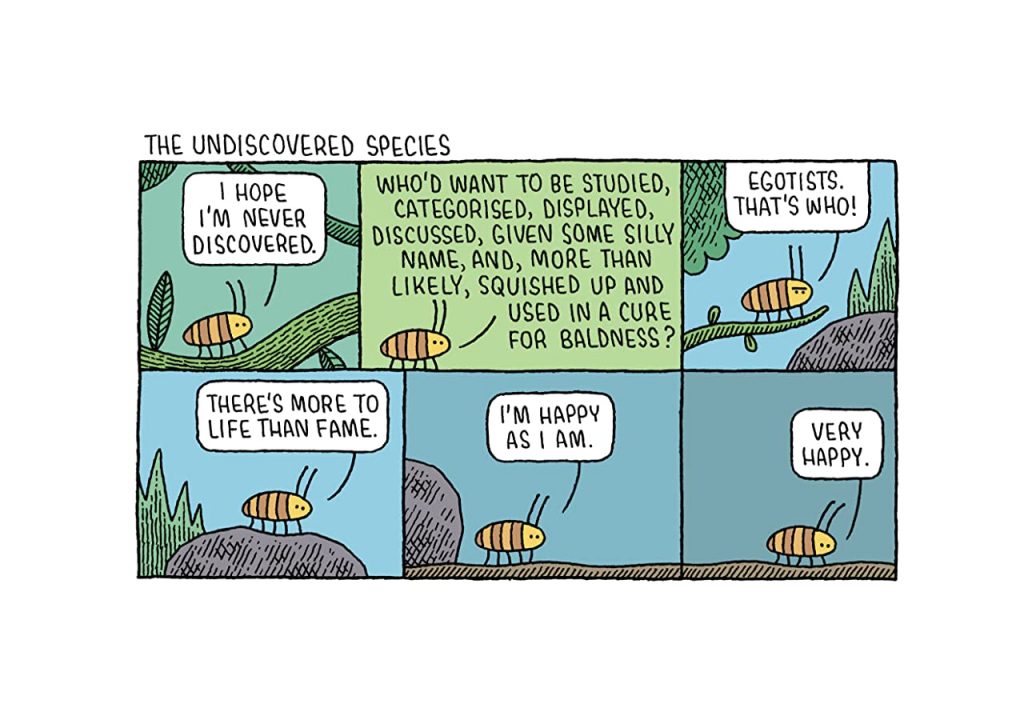
Not that I have to stick to science comics for Brian, right? My assumption that he’d love anything with a science joke in it is probably a bit like my non-comics friends’ assumption that I give a shit about the Marvel Cinematic Universe! Who’s to say Brian isn’t well-rounded enough to also enjoy, oh, I don’t know, say, a comic about people who work in an office, who have been described as ”intricate characters in their world of crushing work and bizarre play?” That’s from the glowing intro written by Ben Passmore for my book, Meeting Comics, by the way.
Yeah, I think Brian would like a copy of Meeting Comics. I’m glad I thought of that.
FANGS, by Sarah Andersen (Andrews McMeel)
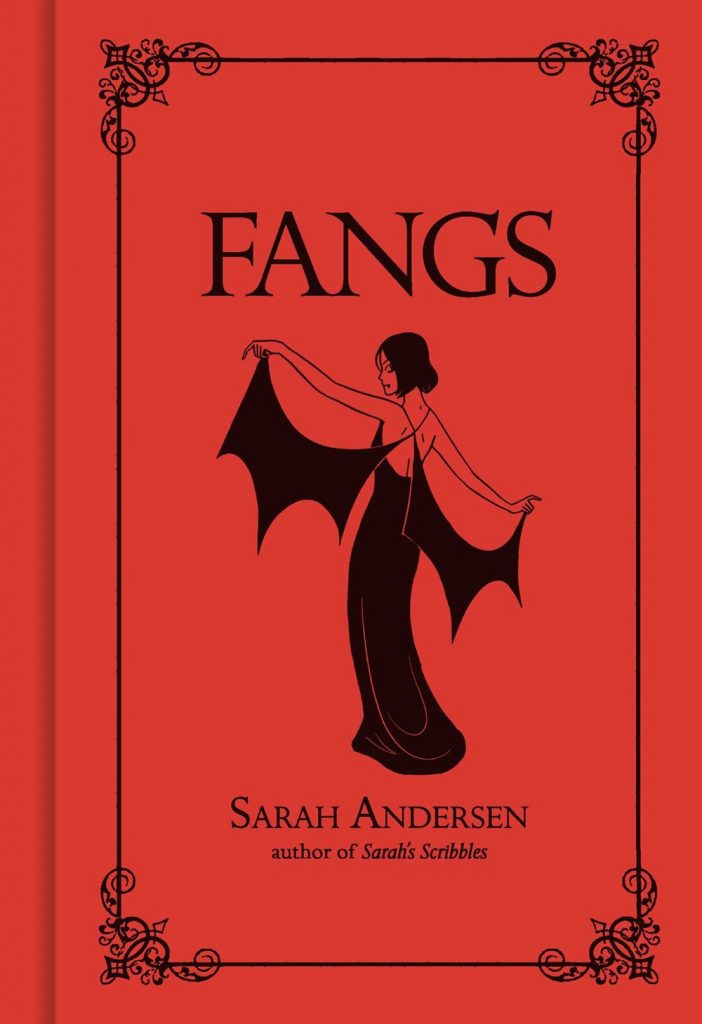
FANGS is a quick read about a vampire and a werewolf who have a romantic relationship. It’s cute through and through, from concept to art. On the cute horror scale that runs, uh, let’s say from Courtney Crumrin to a Freddy Krueger Funko Pop, this is kind of in the middle, but thankfully closer to the Crumrin side. It’s well drawn and fun to read. FANGS is maybe the lightest of the nominees this year as far as story; it’s a bunch of short comic episodes where the werewolf does a dog thing or the vampire is invisible in a mirror, or they’re bonding over the fact that they kill people. All the punchlines are pretty similar, but there’s nothing wrong with them.
There are some really nice individual images in here and the book has a lovely cover. I would say it’s a really solid gift book for your friends who like spooky, cute stuff. I am glad that the nominees are all so different. I appreciate that collections of short comic strips are represented as well as longer narratives.
I did feel like there was more of a build-up of momentum in FANGS than in Department of Mind-Blowing Theories. FANGS is a very short book, though, so depending on what you’re looking for, it may seem like there’s nowhere for that momentum to go, especially since so many of the gags are so similar.
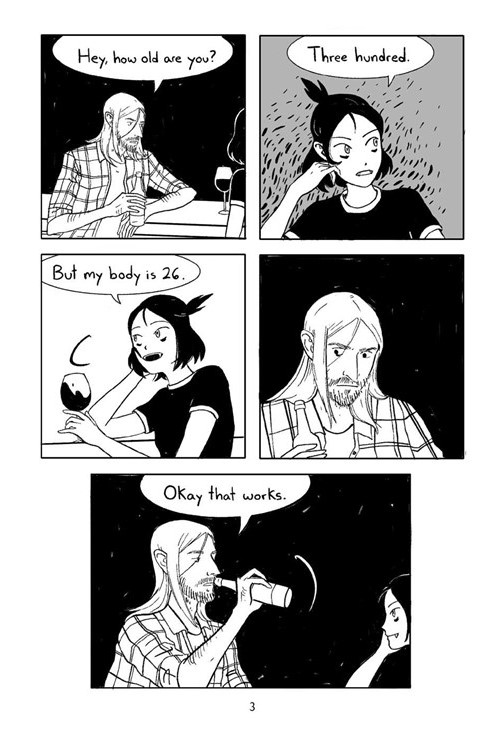
That’s something that always gets me about most comic strips, honestly. Just because you have the same characters in the same setting from strip to strip doesn’t mean you have to keep using the same jokes. Take Kevin, my character from Meeting Comics, for example. The basic joke is that he’s an anarchist in his thirties who has to get a straight job because he has a family now. Who can’t identify with that feeling that your life just isn’t going to work out the way you wanted it to? But not every joke with Kevin has to be universal! It’s the individual details about his life that make him a well-rounded character.
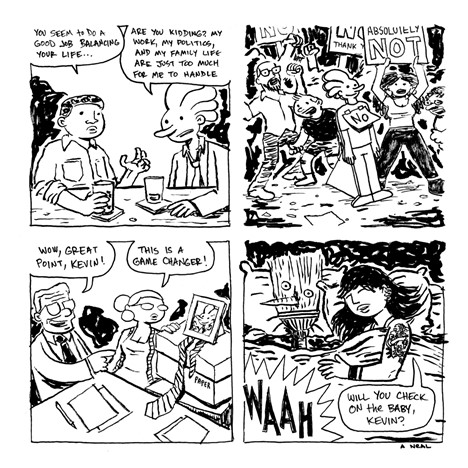
Sure, it’s funny to see him punching a Nazi in his first appearance, and then to see him yanking down a Confederate statue, but that’s not all he is! He has a family and a band! He’s complicated in ways you don’t expect, just like all of us are!
Superman’s Pal Jimmy Olsen, by Matt Fraction and Steve Lieber (DC)
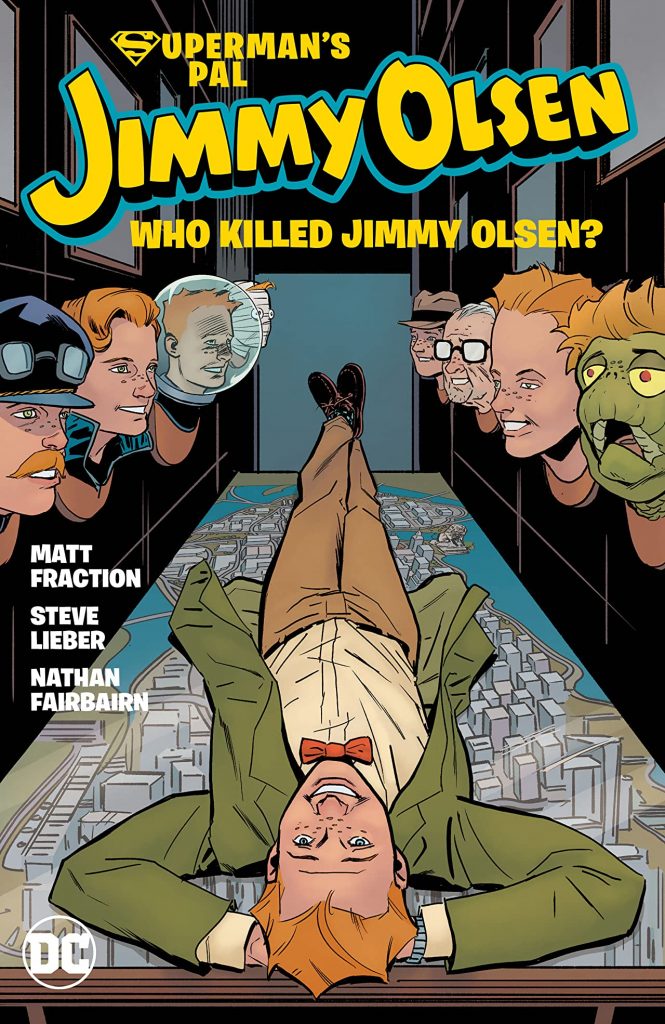
When I was a kid, I bought every “funny” superhero-adjacent comic I knew about and could afford, from Captain Carrot to Power Pachyderms. It’s possible for these books to actually be funny; Damage Control, Ambush Bug, and the Steve Mellor-drawn backups in Spider-Ham all come to mind, but most of them range from “funny for a superhero comic” to “have you guys ever actually heard a joke in your lives?” I knew a kid in junior high who told me his favorite comedian was Arnold Schwarzenegger because of the one-liners he muttered in movies as his characters killed dudes. I guarantee you he’s the type of person who thinks Deadpool comics are funny.
Alright, what was I talking about? Oh, right. Jimmy Olsen. Matt Fraction can write. I own a copy of the Hawkeye stuff he wrote, okay, and not just for the David Aja art. A lot of the dialogue in that comic is, in fact, funny. And you know, Steve Lieber’s no slouch. He’s proven over the course of his career that he can draw almost anything, the exception being Jimmy Olsen’s hair. What I’m saying is I gave this thing a shot. There are funny ideas here, but there are also a bunch of captions.
These captions are used to introduce various characters and scenarios. They’re wordy and bombastic on purpose, with a wink to the reader that says, “This is funny because I’m saying it this way,” and you know, I get why it seemed like a good idea, but to me, it kind of makes it less funny.
There are some good bits, some of which require more DC Comics experience than others to get the joke. Batman being upset that people don’t think he’s funny is funny, because I have read a Batman comic or seen a Batman movie or cartoon. The newspaper article about the four Jimmies who replaced Jimmy Olsen after his apparent death is funny, because I read Reign of the Supermen. Opal City being full of hipsters dressed like Jimmy is funny, because I’ve read Starman. The panel of a gorilla pilot wearing Enemy Ace’s helmet and saying “Ook ook” is funny regardless of whether you’ve read Enemy Ace!
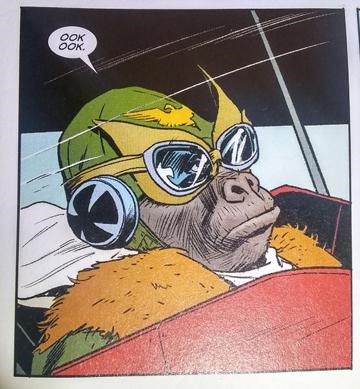
But Jimmy’s extended family, and the history of the Olsens and the Luthors, and the hyper-clever narration knock the overall humor level down a couple notches. Still, it’s better than most funny takes on superheroes.
But is it the funniest take? It is even the funniest take from a comic published in 2020? Not a fucking chance, pal.
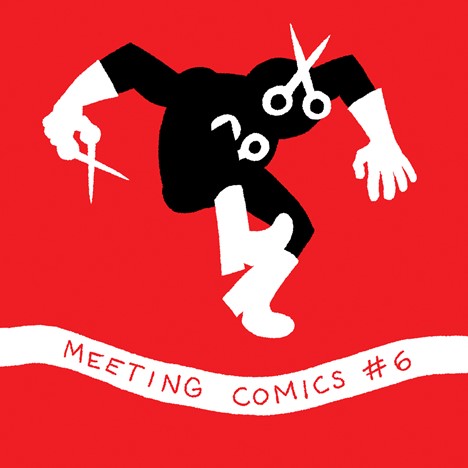
That’s the cover to issue 6 of Meeting Comics, the last issue collected in my book, which was NOT NOMINATED for an Eisner award. I’m not going to mince words here. When people see this comic on the table at a con, fest, or expo, They say, “What’s up with the scissors guy?” and I respond, “That’s the Ribbon Cutter. He’s a costumed vigilante who shows up at ribbon-cutting ceremonies and cuts the grand opening ribbon before the mayor has a chance.”
And they literally laugh out loud right there in public. Because it’s funny. It’s funny enough that a good amount of the time, they buy the issue based on that interaction even if they haven’t read any others.
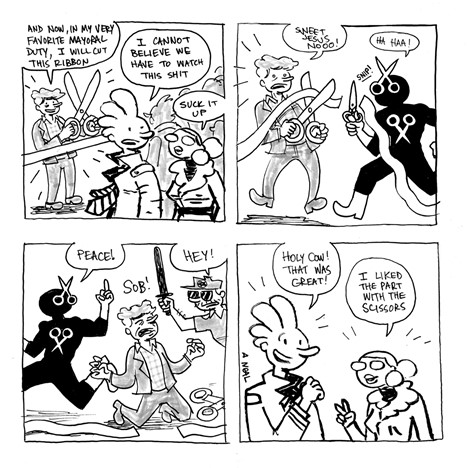
But I guess it’s no “Jimmy Olsen, but written by the guy who wrote Sex Criminals.”
Wendy, Master of Art, by Walter Scott (Drawn & Quarterly)
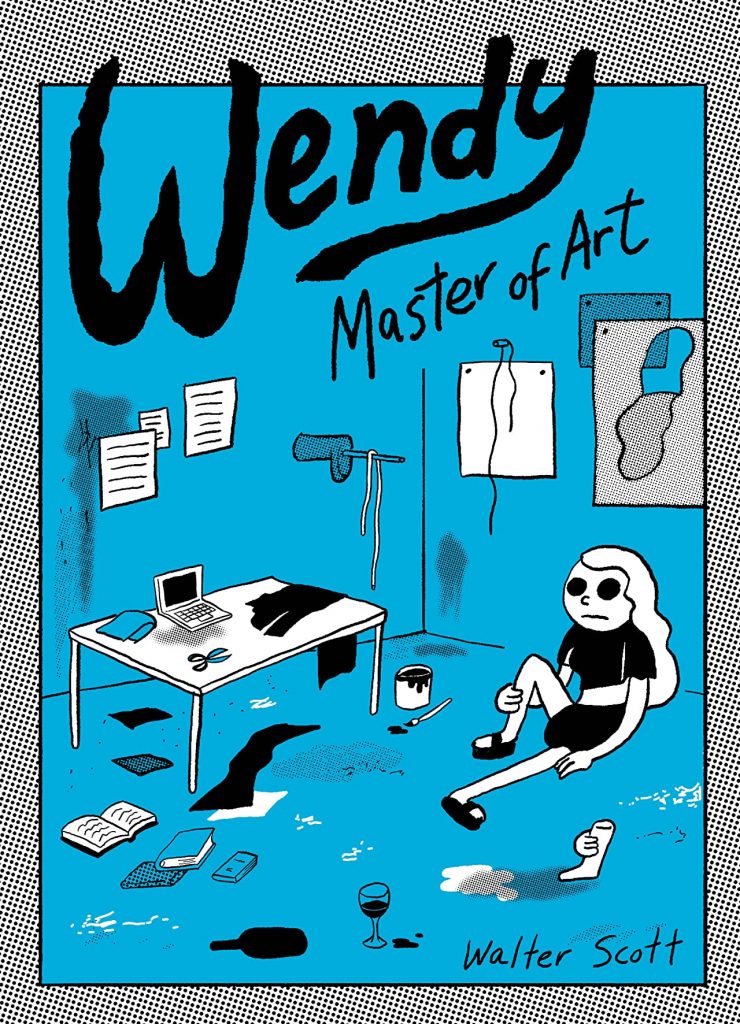
Wendy, Master of Art, has a lot of overlap with Fante Bukowski. They’re both–
OK, come on, who were the judges for the Eisners this year? I mean, I was a retailer for twenty years. Fifty percent of the time I at least know the retailer judge.
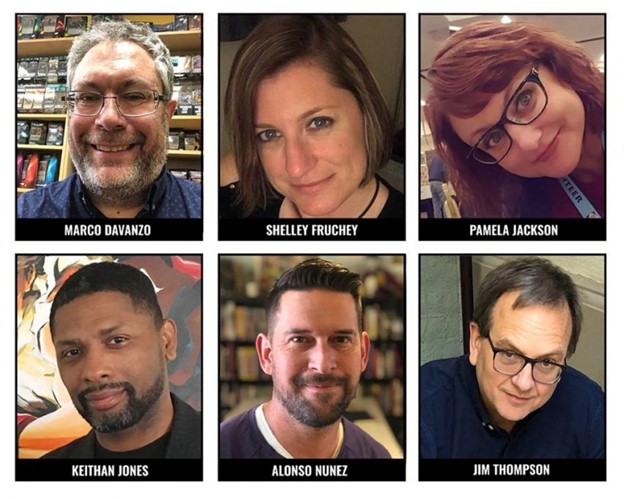
Marco?
Marco Davanzo?!
Marco Davanzo, Executive Director of ComicsPRO, who personally hired me to create the logo for ComicsPRO’s Local Comic Shop Day event? I gave you a good deal on that design work, man. It’s … you know … it’s okay, but that’s not the point. The point, Marco, is that you didn’t see my name on a book and have warm enough thoughts to push it forward in the nominating process? Come on, guy. I’m an ex-retailer. I thought that made us, like, brothers in arms or something.
Not that I need any nepotism! My shit is funny.
It’s who you know, huh?
Sure. Sure it is. Let… let me start over on this one.
Wendy, Master of Art, by Walter Scott (Drawn & Quarterly)

Wendy, Master of Art, has a lot of overlap with Fante Bukowski.They’re both satirical looks at a segment of the arts which skewer the inherent pretensions of each. Walter Scott’s art in Wendy is simple. The crude elasticity of Wendy and the other characters is an asset; the way they are depicted changes with their mood in a way that enhances the humor.
I’ll admit I sighed as I picked this book up because of its thickness – hey, I had six books to get through here – but it was a breezy read which I enjoyed quite a bit. Scott has real compassion for his characters no matter how pretentious they can be, and no matter how badly they treat each other. This balances well with his cynicism about art and academia and the end result is at least as sweet and humane as it is cutting.
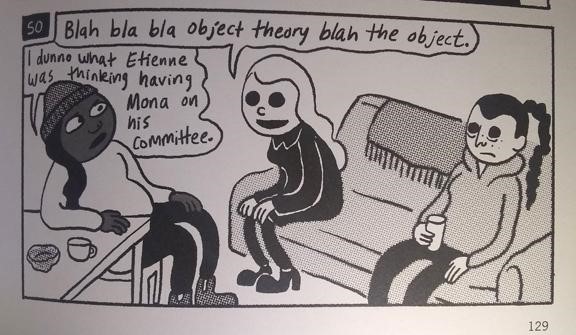
I think this is probably my pick for the Eisner this year, AT LEAST OF THE ONES THAT WERE ACTUALLY FUCKING NOMINATED.
What If We Were . . ., by Axelle Lenoir (Top Shelf)
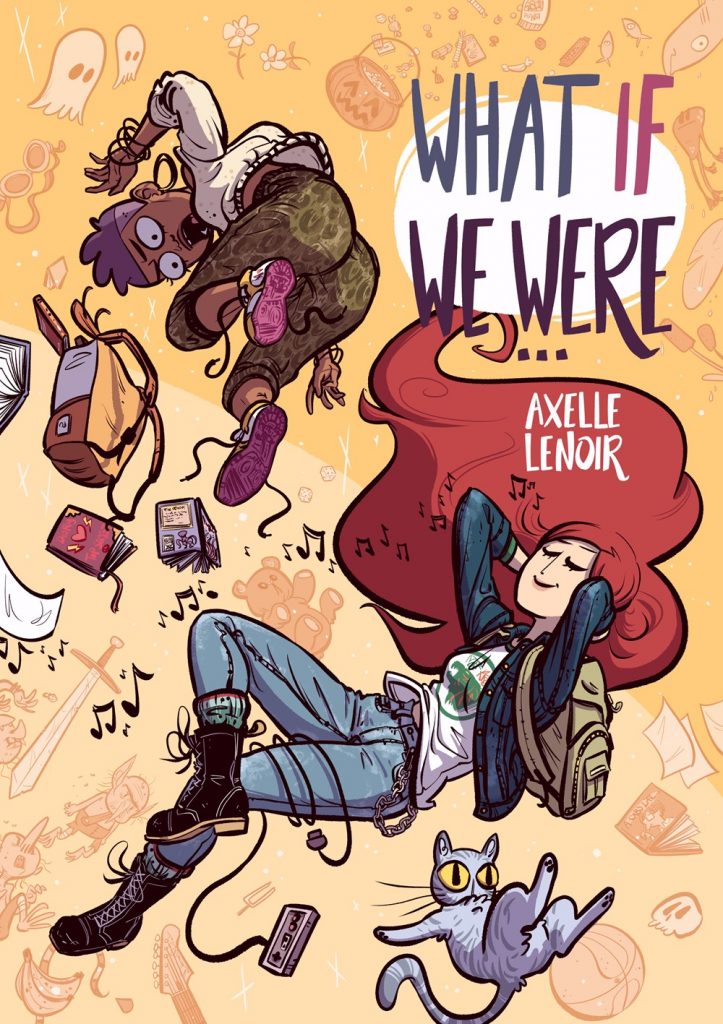
This is a sweet comic about two high school girls who are learning about themselves as they move through life. It’s well drawn, and has nice colors. I didn’t really find it funny, but I’m not the intended audience for this book, and I think it would play well for young adults. Much of the book is based around the premise that two friends, Nathalie and Marie, play a game where one asks the other a question that begins with “What if we were,” and then they answer the question. This serves to show the reader who the characters are, and it works pretty well!
There’s more than this to What If We Were…, though, including pages comprised of walls of text. There are diary pages, as well as pages of dialogue with tiny little heads next to them while the characters riff on various topics. These pages don’t do it for me.
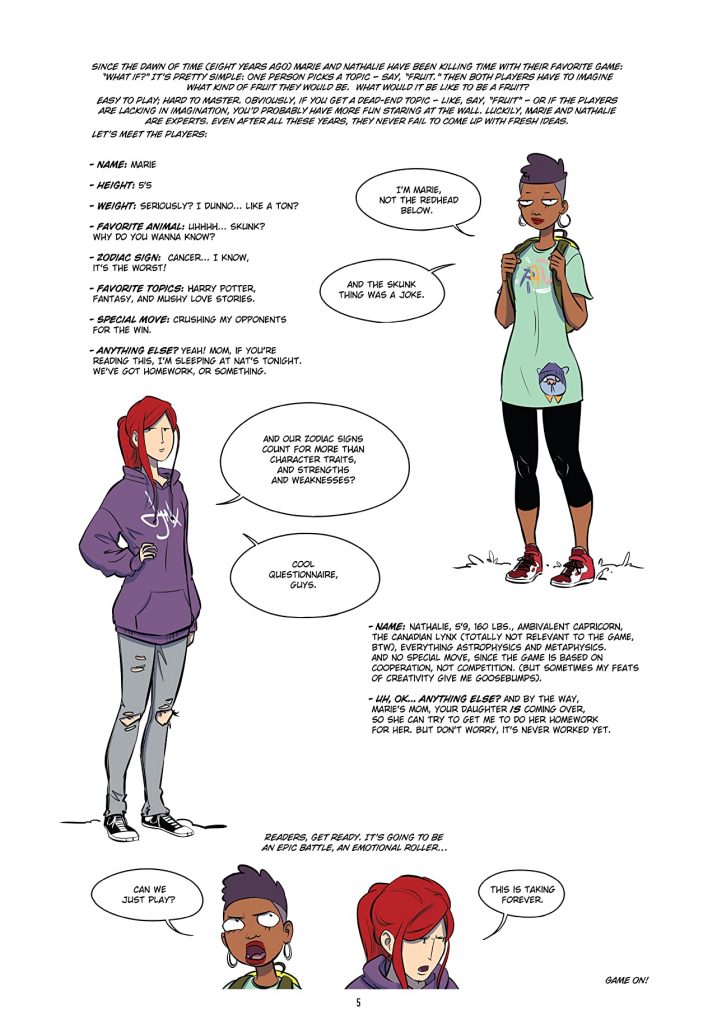
But that’s what happens, right? You pour your heart and soul into something, and sometimes people just don’t connect for some reason. No matter how fucking funny it is. But you don’t get bitter. You persevere, right? You keep moving. One foot in front of the other.
Uh…
What was I… Diary pages, text walls… oh yeah. Right, right.
I don’t want to McCloudkeep and say what is and isn’t a comic, and I don’t want to say that a creator shouldn’t integrate non-comic pages with their comic. I will say that the text pages here break up the flow of the book in a way that makes it less fun for me to read, seemingly in the name of cramming in more information about the characters using fewer pages. It’s hard to make this work. I didn’t like it in Watchmen, either.
Hey, you know, speaking of Watchmen, I’ve got a good Watchmen joke. It’s in issue ten of Meeting Comics, which means it would have been in volume two of Meeting Comics. Maybe it still will be, but it’s not gonna be an Adhouse Book. Adhouse is shutting down, did you know that? Chris Pitzer is pulling the plug. He’s a great guy. I’ve learned a lot from knowing Pitzer and watching the way he treats people. He doesn’t presume to teach, he just does what he thinks is right. He always takes the high road.
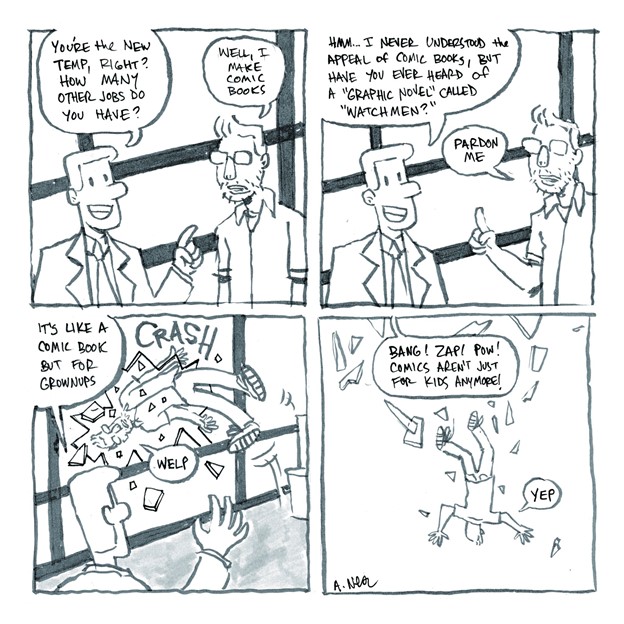
He would never, for example, tell people the reason he’s retiring from publishing is that he’s hurt. That there’s an empty void in his heart. That there’s a hole inside him, put there by the Eisner judges when they neglected to make Meeting Comics one of the finalists for Best Humor Publication.
Who could blame him if he did say that? Literally no one. After all, he’s the master curator who found the diamond in the rough. He’s the champion who recognized genius and decided that it needed to have an ISBN slapped on it so that it could be shared with the world at an extremely affordable $14.95.
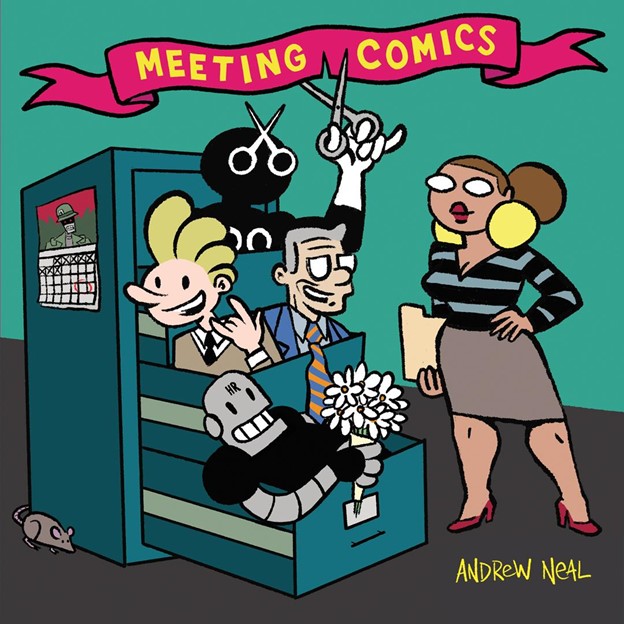
But Pitzer would never say that in his press release because he’s a kind man. The kindest, honestly.
I’ve stayed in Pitzer’s house. I’ve lost track of how many times he’s bought me dinner over the years. That time I saw Noah Van Sciver sigh and eat pizza at the same time? Pitzer paid for that pizza! Heroes Con, 2014! Brixx Wood Fired Pizza! It was close enough to walk to from the convention center, but far enough away it wasn’t slam full of nerds!
I may not have a seat at the table at the Eisner’s but at least I had one at Brixx.
I can’t believe you would do this to Chris Pitzer, Eisner judges. You’ve basically killed alt comix.
I hope you’re happy.
Getting back to What If We Were…, maybe the text wall thing is a generational difference. If one of you Zoomers somehow winds up on SOLRAD and makes it to the end of this article (I know, I know, TLDR!), please weigh in in the comments section, preferably not in text wall form! Ha ha!
In conclusion, the nominees for the Best Humor Category all have a lot to offer the reader, from the story of the romance between a vampire and a werewolf, to the depiction of an incompetent writer who is so lacking in self-awareness that he truly believes everyone else in his chosen field is an idiot who just can’t recognize his genius –
Wait, why are you looking at me like that?
Seriously, why?
WHY ARE YOU LAUGHING?
SOLRAD is made possible by the generous donations of readers like you. Support our Patreon campaign, or make a tax-deductible donation to our publisher, Fieldmouse Press, today.

Leave a Reply